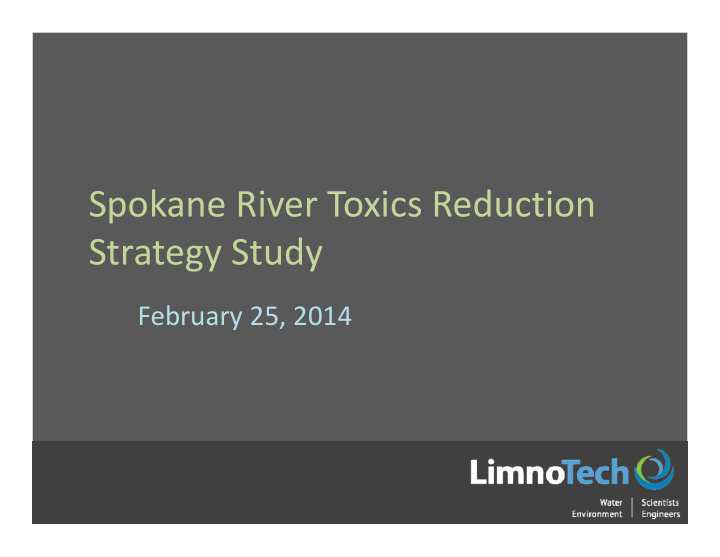



Spokane River Toxics Reduction Strategy Study February 25, 2014
Presentation Outline • Sampling and Analysis Plan • Quality Assurance Project Plan 2
Sampling and Analysis Plan • Project Organization • Project Description • Field Methods and Procedures • Sample Handling and Storage • Sample Documentation • Quality Assurance/Quality Control 3
Project Organization • To be decided – Project Manager – Technical Advisor – QA Officer – Field Manager – Lab Technical Director – Lab QA/QC Manager 4
Project Description • Purpose – collect necessary data to eliminate the data gaps in order to conduct a PCB mass balance assessment • Phase 1: – Review data/identify data gaps – Prepare monitoring plan to address data gaps – Prepare refined SOW for subsequent phases • Phase 2 – Implement the monitoring plan 5
Project Description • Phase 3 – Analyze the collected data – Characterize PCB sources • Phase 4 – Assess potential BMPs – Develop Comprehensive Plan 6
Data Collection – 1 st Year • Confidence Testing • Synoptic Study • Seasonally Integrated Sampling 7
Confidence Testing • Conducted before March 31 st • Samples collected at Lake Coeur d’Alene outlet • Grab samples collected on 5 days • Duplicate collected and analyzed each sampling day • 1 sample each day to be composited • Analyze for: – PCB congeners – TOC – DOC – TSS – TDS 8
9
Synoptic Survey • Conducted during summer low flow period • Samples collected at: – River locations with flow gaging stations (7 locations) – NPDES permitted dischargers (8 locations) – Hangman Creek mouth 10
Synoptic Survey • Gage locations ‐ samples collected every other day over 2 week period • Dischargers – samples collected on 3 separate days • Samples collected: – Individual grab – Sample for composite • Parameters: PCB, TSS, TDS, TOC, DOC 11
12
Seasonally Integrated Sampling • Sampling conducted: – Spring high flow – Summer low flow (covered by Synoptic Survey) – Winter moderate flow • Samples collected at Lake Coeur d’Alene outlet • Samples collected on 5 separate days – 2 days between events • Samples collected: – Individual grab – Sample for composite • Parameters: PCB, TSS, TDS, TOC, DOC 13
14
Seasonally Integrated Sampling • Sampling conducted: – Spring high flow – Summer low flow (covered by Synoptic Survey) – Winter moderate flow • Samples collected at Lake Coeur d’Alene outlet • Samples collected on 5 separate days – 2 days between events • Samples collected: – Individual grab – Sample for composite • Parameters: PCB, TSS, TDS, TOC, DOC 15
Field Methods and Procedures • Samples collected in accordance with EPA Method 1669 – 2 person team – Clean hands/dirty hands • River samples: – Direct immersion or Dip sampler – Use clean bottle/do not reuse • Discharger Samples – 24 hour composite 16
Sample Handling, Storage and Shipment • Samples clearly labeled • Stored at 4 degrees C • Bottles specified • Shipping instructions 17
Sample Documentation • Field Forms • Calibration records • Chain of Custody 18
Quality Assurance Project Plan • Data Quality Objectives • Analytical Methods • Quality Control • Assessment and Oversight • Data Validation and Usability 19
Data Quality Objectives • Accuracy – estimate of total error from a single measurement – Lab control samples ‐ % recovery • Precision – measure of reproducibility – Matrix spikes/matrix spike duplicate • Representativeness – sample data accurately reflect the characteristics of the population of samples – Follow procedures • Completeness – measure of amount of valid data compared to what was planned • Comparability – confidence in the comparison of one dataset to another – Maintain standard techniques and procedures 20
Analytical Methods • PCB – EPA Method 1668C • Total Organic Carbon – EPA Method 415.1 • Dissolved Organic Carbon – EPA Method 415.3 • Total Suspended Solids – EPA Method 160.2 • Total Dissolved Solids – EPA Method 160.1 21
Quality Control Samples • Lab QC – Method blanks • 1 per sample batch • Monitors background contamination • Samples flagged if less than 3 times the blank concentration – Laboratory control samples • 1 per sample batch • Reagent water spiked with analytes of known concentration – Lab duplicate • 1 per sample batch • Split sample to measure precision of analytical method 22
Quality Control Samples • Lab QC – PCB – Labeled compounds • Carbon 13 isotopes • Spiked into all field and lab samples at different points in the process • % recovery 23
Quality Control Samples • Field QC – Replicate • Collected for every sample – stored • Analyzed 1 in 10 – Equipment/field blanks – 1 in 20 samples – Trip blank 24
Data Validation • Data Verification – Screen field data sheets – Review chain of custody documentation – Screen lab data sheets – Examine calibration and QC data daily • Data Validation – Evaluate data against the Data Quality Objectives – Data flagged 25
Recommend
More recommend